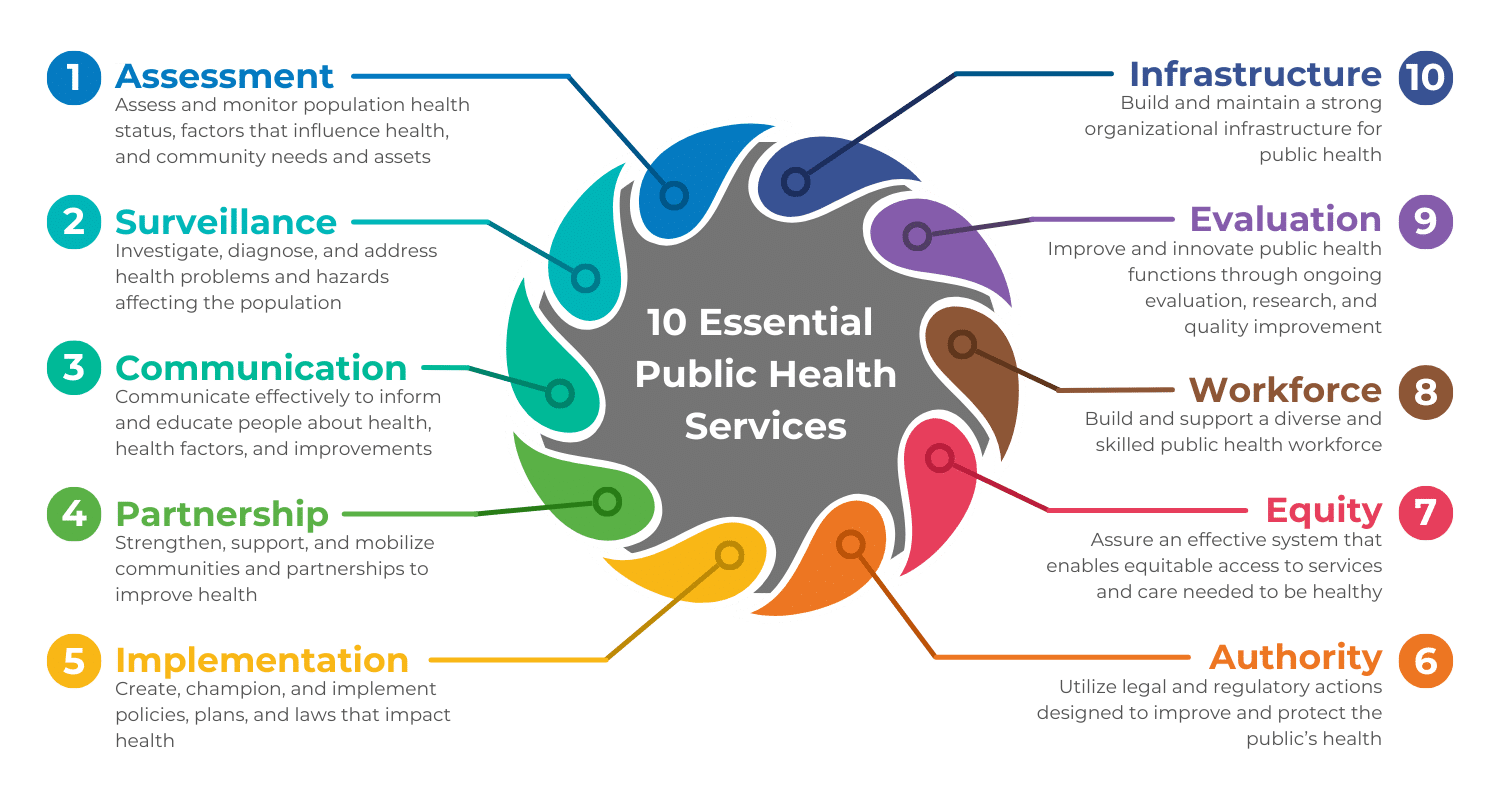About Public Health

What is Public Health?
Public Health promotes and protects the health and well-being of people and communities. Public Health’s mission is to “fulfill society’s interest in assuring conditions in which people can be healthy [and well]” (Institute of Medicine) and provide “maximum benefit for the largest number of people” (World Health Organization). C.E.A. Winslow, a seminal figure in early American public health practice, defined public health as “The science and art of preventing disease, prolonging life, and promoting health through the organized efforts and informed choices of society, organizations, public and private communities, and individuals.”
Public Health aims to enhance the health of communities–emphasizing disease prevention, health promotion, and equitable access to services and vital community conditions that all people need to be healthy and well.
Our Public Health System
Public Health’s mission is carried out through The 10 Essential Public Health Services, an important framework that describes the public health activities that all communities should undertake.

It takes a large, capable, and diverse workforce to deliver the Essential Public Health Services, encompassing various sub-fields and specializations that include disease prevention, health promotion, policy development, research, environmental health, and epidemiology. Collectively, the Essential Public Health Services and the organizations and institutions that exist to provide them are our public health system.
Governmental Public Health operates at local, state, national, and international levels, through a network of city and county local public health departments, state health departments, and national and international authorities. Our public health system, however, is bigger than government alone. It includes a robust network of non-governmental organizations and other Stewards working in concert to ensure health, well-being, and equity for all.
Public Health Versus Healthcare
Public Health and Healthcare are two distinct but interconnected sectors that play pivotal roles in maintaining and improving the health of populations. Public Health is a broad discipline focused on population-wide health, well-being, and equity. The so-called “public health approach” emphasizes preventive measures, health promotion, and addressing root causes of poor health. Public health professionals work to create policies, conduct research, and implement programs that target a wide range of health concerns, such as sanitation, nutrition, immunization, and disease prevention. Some public health departments also provide health care services.
In contrast, the Healthcare sector exists to deliver medical services and health care to individuals. The sector includes a vast network of clinics, hospitals, and care facilities, and practitioners including doctors, nurses, and allied health professionals. Healthcare provides diagnosis, treatment, and care for patient health needs, as well as preventive services and patient education.
The two sectors often work together on issues of public health concern, for example, promoting flu vaccination or providing sexual health education. With Public Health working upstream to improve population health, well-being, and equity, and Healthcare working on the frontlines to provide services and care, the two sectors, in concert, safeguard and support the health of people and communities.
A Brief History of Public Health
Knowledge and wisdom about health has influenced physical and social dimensions of communities since ancient times. Practices to protect and promote health such as personal hygiene, sanitation engineering, isolation and quarantine, organization of medical care, and separation of land uses in urban settlements were developed by early societies around the world. Approaches to protect and promote health evolved with social and scientific advancements over the centuries.
In the 19th and 20th Centuries, public health witnessed a profound transformation driven by: scientific discoveries and advancements like the Germ Theory and epidemiology; medical innovations like vaccination and antibiotics; improved healthcare delivery and hospital reforms; and the development of the Public Health administrative state. Control of vaccine-preventable infectious diseases, antibiotic treatment of acute infectious diseases, increased emphasis on child and maternal health care, and improved nutrition and living standards contributed to significant gains in health, quality of life, and life expectancy over the period.
In the second half of the 20th Century, as infectious disease deaths declined and people began living longer, non-infectious disease deaths rose in public health significance. This dynamic shifted Public Health’s focus from infectious diseases, like polio and syphilis, to non-infectious diseases, like cancer and cardiovascular disease.
Public Health Today
Today, Public Health is charged with promoting health, preventing disease, and addressing issues of equity and justice across a spectrum of issues, from infectious diseases and chronic health conditions to environmental and occupational health hazards and social determinants of health. Modern Public Health practice emphasizes:
- Implementing upstream approaches that improve vital community conditions
- Transforming policies, systems, and environmental practices to achieve change at scale
- Removing systemic barriers that prevent people from having equal opportunities to be healthy and well
- Engaging community to better understand issues that affect health, and design and implement solutions
- Collaborating with partners, across organizations and sectors, to achieve more together
Public Health, however, faces real challenges that include inadequate funding, workforce development and diversity needs, coordination between local, state and national authorities, and eroding public health authority. COVID-19 brought many of these challenges to the fore, and over the last several years, Public Health has mobilized to address them.
Reflection Questions
- How would you describe the role of Public Health today in contrast to the 19th and early 20th Centuries?
- What is an example of a policy, plan, or law that has strengthened the public’s health, well-being, and equity?
- How can the Essential Public Health services be leveraged to remove systemic barriers that prevent people from equal opportunities to be healthy and well?
